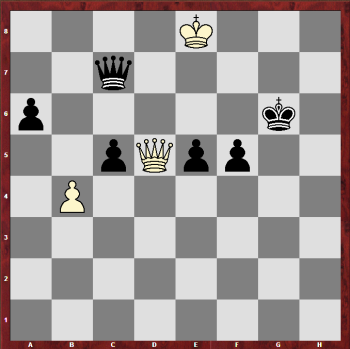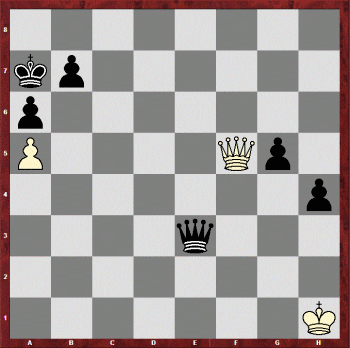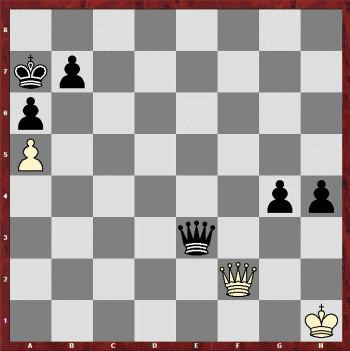Chess Tip and Chess Puzzle Answer Discussion with Dennis Monokroussos
In our first post we came across this position, from a chess game I played back in 1999.

Monokroussos, Dennis – Barcarola, Lou, US Amat. Team East 1999
Queen endings can be challenging to win, but that’s usually when a player is only one pawn up. Here my opponent is three pawns up, with a chance to go up by four. My last move was 53.b3-b4; should he take it?
Having had a few days to think about it, I hope you all saw that the answer is a resounding “no!” Fortunately for me – very fortunately! – he relaxed a moment too soon and took the pawn with 53…cxb4?? That gives him more than enough extra material to win, but allows me to escape with 54.Qd6+! He can’t afford not to take the queen, but after 54…Qxd6 it was stalemate!
In case you’re wondering what he should have done, the most effective move was 53…Kf6! That threatens both 54…Qe7# and 54…Qc8+, and leaves me with nothing better than 54.Qxc5. Unfortunately, after 54…Qxc5 55.bxc5 Ke6 he is just close enough to my c-pawn to capture it, and I would have had to resign. It was a very close call!
The moral of the story is that we cannot relax until the game is over. Everyone from beginner to grandmaster is capable of making such lapses. That’s a comfort in a way – even the world’s best players are human too, after all – but it’s also a warning – we’ll never outgrow the need for vigilance. Just to show that even the best players are capable of mistakes like this, have a look at this position:

Carl Pilnick-Samuel Reshevsky, USA Championship 1942 (92.Qf5)
Strangely enough, the material balance is the same as in my game: Black has a queen and four pawns to White’s queen and one pawn. White has just played 92.Qd5-f5, marking time and seemingly preventing 92…g4. Reshevsky, who was then one of the world’s very best players (and continued to be for another 25+ years) just needs a little accuracy to finish the job. His queen covers the g1-a7 diagonal, so there’s no way for White to force a perpetual check. White’s king has room to move, so there’s no immediate stalemate, and so Reshevsky thought he was clever when he played 92…g4.
The idea is that on 93.Qxg4 Black can force a trade of queens and win on the queenside: 93…Qe1+ 94.Kg2 Qg3+ 95.Qxg3 fxg3 96.Kxg3 and now the king comes around for the a-pawn: 96…Kb8 97.Kf4 Kc7 98.Ke5 Kc6 followed by 99…Kb5 and 100…Kxa5. Clever!
Yes, but not clever enough. After 92…g4?? Pilnick played a great move: 93.Qf2!!

Carl Pilnick-Samuel Reshevsky, USA Championship 1942 (93. Qf2)
As in my chess game, Black cannot afford not to take the queen, and after 92…Qxf2 it’s stalemate.
Please, dear readers, stay alert!
Dennis Monokroussos

Heya i’m for the primary time here. I found this board and I find It truly helpful & it helped me out a lot. I hope to provide something again and aid others like you aided me. Please read me rewiew there http://noviy-dom.zp.ua/
Hello very nice site!! Guy .. Excellent .. Superb .. I will bookmark your web site and take the feeds additionally…I’m glad to find so many helpful info here in the post, we’d like develop more techniques on this regard, thank you for sharing.
Everyone loves what you guys are usually up too. This sort of clever work and coverage! Keep up the very good works guys I’ve incorporated you guys to my blogroll.